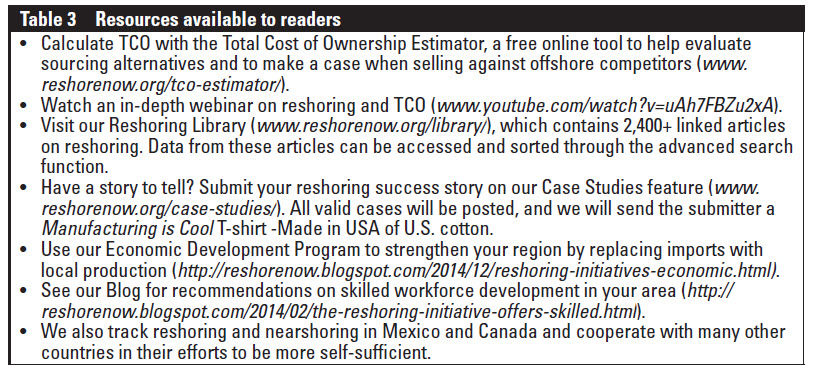Overall there are three main drivers of
the reshoring trend. First are rising offshore
wage rates. Second is an increased
recognition of the previously ignored
costs, risks and strategic impacts of offshoring.
This recognition is enabled by
the use of the refined metrics of total
cost of ownership (TCO) to quantify
these factors. Third is a reduction of
costs through sustainable strategies such
as design for manufacturability, innovation,
automation and lean.
Using TCO is the first step a company
should take when evaluating sourcing
options. TCO is defined as the total of
all relevant costs associated with making
or sourcing a product domestically
or offshore. TCO includes current period
costs and best estimates of relevant
future costs, risks and strategic impacts.
TCO analysis helps companies objectively
quantify, forecast and minimize
total cost. It takes into account transportation
costs, travel expense and time,
carrying cost of inventory, warranty,
IP loss, impact on product innovation,
and many other factors such as those
associated with the risk of supply chain
shocks or disruptions caused by natural
disasters, political unrest and dock slowdowns. It also helps to forecast the future
impact of wage and currency changes.
Much of companies’ efforts to deal
with complex global supply chains is
eliminated or drastically reduced by
reshoring. Longer-term forecasting,
monitoring of suppliers and regulatory
compliance offshore is found to be waste
when measured against the use of proven,
local suppliers.


The not-for-profit Reshoring Initiative
offers the free TCO Estimator, available
on reshorenow.org. The initiative offers
many resources to help companies make
sourcing decisions (Table 3). Reshoring
tools can also be used by gear salesmen
to convince customers of the benefit of
sourcing domestically, especially for custom
gears.
Below are some examples of gear makers
who have chosen U.S. production or
sourcing over offshore.
- Bison Gear and Engineering Corp.
moved production of electric motors
and gears from China to St. Charles,
IL, creating 10 jobs.
–Reasons: Cost, quality, lead time and
lean manufacturing
- Pequea Machine Inc. brought production
from China to the U.S., bringing
contract work to Buck Co. (PA
foundry) and Circle Gear (IL machine
shop), and creating up to 20 new
future jobs (Ref. 1).
–Reasons: Quality (25% of gear boxes
from China failed due to substandard
metals used); equivalent price
(cost was about $900 to produce
gearboxes in the United States, and
between $800-$900 in China); Total
cost
- ZF Group, a Supplier for Chrysler,
brought production from Germany
to Gray Court, SC and Detroit, bringing
1,650 jobs in South Carolina, and
some additional jobs in Michigan. ZF
originally began building gearboxes
for wind turbines in Gainesville, GA
with a $98 million investment, adding
250 jobs.
–Reasons: Time to market, proximity
to market
- Metem Corp., which makes gas turbines
and aerospace industry products,
is expanding its Parsippany, NJ
plant over plants in Pennsylvania and
Hungary. Metem’s CEO on the company’s
growth: “One of the great things
about gas turbines is that the U.S.
really has a leadership position in that
technology. We are seeing our customers bring turbine manufacturing back
to the U.S. from other parts of the
world.”
–Reasons: Highly skilled workers,
access to universities, advanced
manufacturing
Conclusion
The Reshoring Initiative publishes data
(Ref. 3) annually to show that the current
trend in manufacturing for the United
States market is to source domestically.
With 3–4 million manufacturing jobs
still offshore, we see huge potential for
even more growth and hope this data
will motivate more companies to reevaluate
their sourcing and site selection
decisions. Making better-informed decisions
through the use of TCO and gaining
a competitive advantage through
sustainable strategies will enable U.S.
companies to locate more manufacturing
closer to home and strengthen the U.S.
economy.
We would like to build on the reshoring
momentum achieved at the AGMA
meeting. We have outlined (Table 3) our
tools and programs that you can use.
The best way to accelerate the trend is
to document and promote the successful
cases. Therefore, we especially encourage
you to report the cases where you
reshored, where you directly replaced
an imported gear source or where your
customer brought back product assembly
and sourced gears from you. Reports
can be made on our Case Studies feature.
The resulting PDFs will be posted on the
Reshoring Initiative website, and you can
post on your site. Case submitters also
receive a Manufacturing is Cool T-shirt,
made in the USA of U.S. cotton.
References
- www.themadeinamericamovement.com/uncategorized/
pequea-machine-joins-the-reshoringmovement-
reshores-part-production-for-betterquality/.
- www.njbiz.com/article/20130130/
NJBIZ01/130139989/Manufacturer'sexpansion-
in-Parsippany-expected-to-create-jobs-
CEO-says.
- www.reshorenow.org/content/pdf/2014_Data_
Summary.pdf.
About Author
Harry Moser founded the
Reshoring Initiative to bring
manufacturing jobs back to the
United States after working
for GF AgieCharmilles, starting
as President in 1985 and
retiring at the end of 2010 as
Chairman Emeritus. Previously
he worked for Disamatic U.S. for six years.
Largely due to the success of the Reshoring
Initiative, Harry was inducted into the Industry
Week Manufacturing Hall of Fame 2010 and was
named Quality Magazine’s Quality Professional
of the Year for 2012. Moser participated actively
in President Obama’s January 2012 Insourcing
Forum at the White House, won the January
2013 The Economist debate on outsourcing and
offshoring, and received the Manufacturing
Leadership Council’s Industry Advocacy Award
in 2014. He received a bachelor’s degree in
mechanical engineering and a master’s degree
in engineering from MIT in 1967, and he earned
an MBA from the University of Chicago in 1981.










